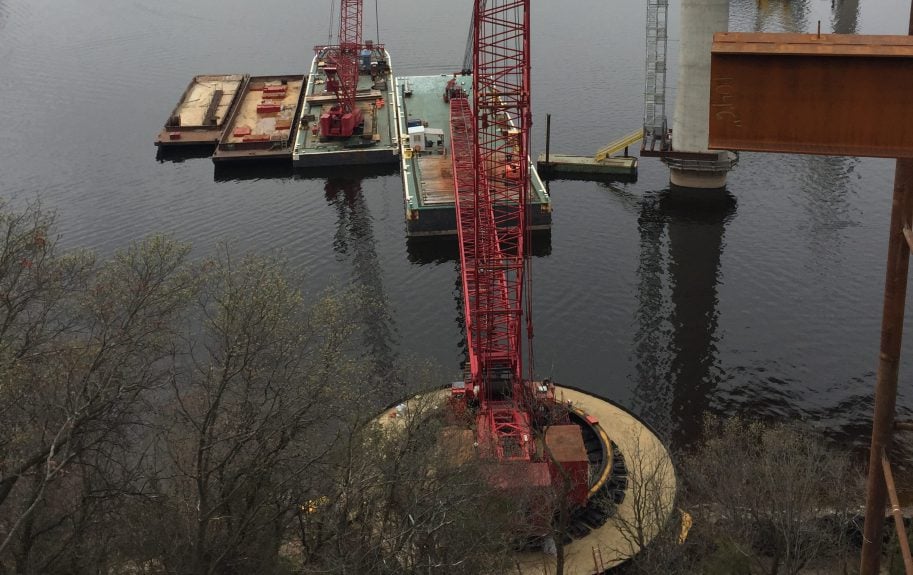The cranes, which can lift 660 tons and have a boom length of 250 feet, will help crews lift and place bridge deck segments at piers in the middle of the river and on the Wisconsin bluff.
The cranes will supplement the work being done by segment lifters.
“It means we can place segments at the five river piers and at Pier 13 all at once,” Paul Kivisto, the Minnesota Department of Transportation’s bridge construction engineer, said during a media tour of the bridge site Wednesday morning.
One of the Ringer cranes is already in place on a temporary pad built next to the Wisconsin shoreline; it arrived in pieces via 50 semitractor-trailer loads. The other is being partially assembled in Winona, Minn., and will be shipped by barge next week; it will sit on an 80- by 260-foot platform in the middle of the river.
The cranes, which can move 360 degrees, will be used throughout the construction season and could be used again in 2017, Kivisto said. He said he did not know how much the cranes, which can rent for up to $80,000 a month, would add to the project’s costs.
A mild winter with minimal snow and an early ice-out have helped the construction schedule, Kivisto said.
“The river opened up early, so we were able to erect some segments earlier than we otherwise would have anticipated, so that’s all been good,” he said.
The bridge was scheduled to open this fall, but MnDOT announced in January that completion would not happen for another year. Officials attributed the delay to equipment problems, material shortages, high water in the spring 2014 and a cold snap in late 2014 that brought ice and low temperatures sooner than expected.
Crews will begin working at night — from 3 p.m. to midnight or 1 a.m. — starting Monday.
“Depending on how it goes throughout the summer, that may be extended to be 24 hours a day,” Kivisto said.
By the end of this year’s construction season, the bridge should begin to really look like a bridge, he said, with the piers cantilevered out to be within 2½ feet of each other.
“The biggest challenge that we have is making sure that our geometry is correct,” Kivisto said. Each segment is surveyed within 1/1000th of a foot — both in the casting yard and on site, he said.
“One of the critical pieces is making sure, geometry-wise, that the cantilevers coming from the two different piers will meet in the middle,” he said. “There’s a little bit of room for tolerance, the ducts themselves can accommodate a couple of inches out of alignment and we also could jack either horizontally or vertically a little bit if needed to put them together.”
Concrete “creeps and shrinks,” so crews must account for that, he said.
The closure pour — the pour that will fill in the bridge’s last 2½-foot gap — will happen between Piers 8 and 9, the ones closest to the Minnesota side of the river, Kivisto said.
“There are some structural reasons for that,” he said. “(Pier 8 is) the pier that is the shortest. It’s also the one that has the most force because of the amount of movement experienced there.
He said the closure pour will likely happen in spring of 2017.
About 200 workers are employed at the site and at the casting yards near the Minnesota 36-Minnesota 95 interchange and at Grey Cloud Island. About 400 workers are expected to be on the payroll this summer.
About 25 percent of the segments on the main span are erected, and about 50 percent of the segments on the approach spans are erected, Kivisto said.
The new bridge will connect Oak Park Heights and Houlton, Wis., and will replace the aging Stillwater Lift Bridge, which will become part of a hiking and biking trail.
The estimated cost of the project, which includes approach work and creating the trail, is $580 million to $646 million. Construction of the bridge foundation began in the spring of 2013.
By MARY DIVINE | [email protected]
Staff photographer Bill Klotz watched construction crews work on the bridge project:













